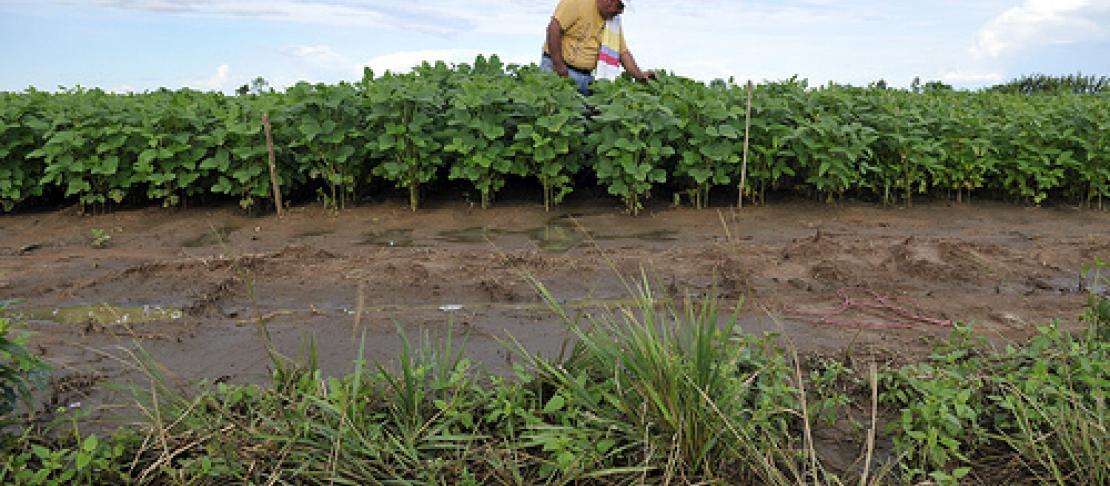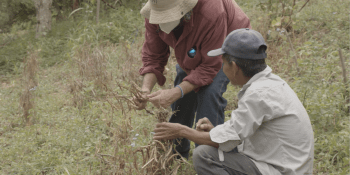Farmers map strategies to adapt to climate change in Colombia

How will rural communities adapt to climate change? A common criticism is that governments focus too much on top-down approaches to climate change adaptation, without considering the needs of local, rural communities.
As a response, several development agencies have developed participatory planning tools to allow communities to be involved in decision-making processes and share their valuable knowledge and solutions to climate change.
These tools include FAO’s e-learning tool, International Institute for Sustainable Development (IISD)’s Cristal Tool, CARE's Climate Vulnerability and Capacity Analysis Handbook.
These tools help local communities and scientists work together to identify local, daily impacts of climate change and work out feasible solutions. However, little is known about whether they actually capture all the information relevant to establish climate change adaptation plans.
Bioversity International has initiated a project in collaboration with the Institute for Development Studies, to test how well these tools can diagnose a community’s vulnerability to climate change.
Last April, Bioversity scientists began working with two rural communities situated in the breath-taking Chicamocha canyon in the Colombian Andes, one of the deepest canyons in the world. The Chicamocha canyon is considered one of the most vulnerable regions to climate change in Colombia, as water shortage and desertification have been increasing in the last decades (IDEAM report 2010).
With the help of Fundación Conserva - a Colombian partner working in the area since 2004 - Bioversity set out to better understand the different perspectives of men and women, and gain insights about their vulnerability to climate change. The work was undertaken through a workshop and survey using a combination of participatory approaches.
 A major challenge was to ensure that farmers attended the workshop, as participation meant forgoing valuable hours of work. The workshops did not offer any direct economic benefit, but previous visits to the area had helped to build personal relationships with the local com
A major challenge was to ensure that farmers attended the workshop, as participation meant forgoing valuable hours of work. The workshops did not offer any direct economic benefit, but previous visits to the area had helped to build personal relationships with the local com munity, and invite them in person to participate.
munity, and invite them in person to participate.
At the workshop, the farmers learned about some of the adaptation strategies they could try out, for instance by testing seeds for different crops and varieties. Seeds are an area of strong interest to these communities, mainly because they lack access to even small amounts for home garden crops. As a result, people were very receptive, and welcoming, sharing a little of their lives too.
During the workshop, participants were asked to draw a map of their community in order to identify the main physical, natural resource and climate risks that affect their economic well-being.
Drawing and painting key aspects of their territory such as houses, main crops, streams and forests, was one of the activities that the participants enjoyed most, and was important for understanding community dynamics, climate hazards, and how to plan for risk reduction.
The workshop allowed researchers to gain insights into how climatic events affect local resources. Communities have to cope with long periods of drought that affect their crops and limit crop diversity in the region. Furthermore, certain important crops in the region, such as fique — a fibre-producing plant — are also suffering from various threats.
One lesson the organizers learned from the workshops is that these participatory tools need to be part of a wider process of involving the community in adaptation interventions with clear benefits. This could be done in combination with seed introduction, such as Bioversity International’s Seeds for Needs project, or through community innovation funds, such as the Local Innovation Support Funds mechanism developed by Prolinnova, a partner organization of the CGIAR Research Program on Climate Change, Agriculture and Food Security (CCAFS).
More on the ‘Seeds for Needs’ project: Farmers become citizen scientists: Testing wheat crops for climate change adaptation
Bioversity will continue to work with this community, and carry out more meetings throughout the year to identify local climatic trends, the seasonality of crops in relation to these trends, the level of impact that climate hazards have on livelihoods, and local adaptation strategies. It is important to improve participatory methods for assessing climate change vulnerability to ensure adaptation strategies respond to local needs.
View more photos: "Climate change adaptation in the Americas" by Bioversity International
This story was also published in the Bioversity International website
Read also:
- Participatory approaches give women a voice in climate adaptation
- Rural communities get 'hands-on' with climate adaptation planning
- Participatory videos in Nepal: Voicing women’s perceptions on climate change
This story was written by Marcela Beltrán, from Bioversity International. CCAFS is expanding into parts of Latin and Central America. More news on this process coming up, but in the meantime read about our latest expansion into Southeast Asia.



